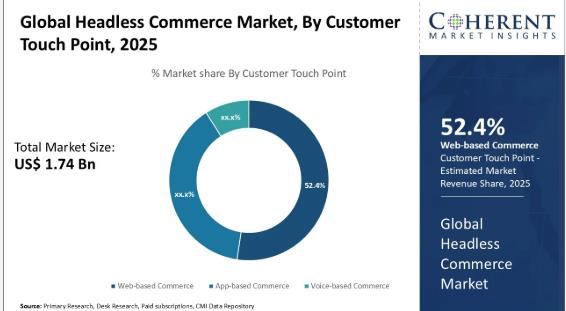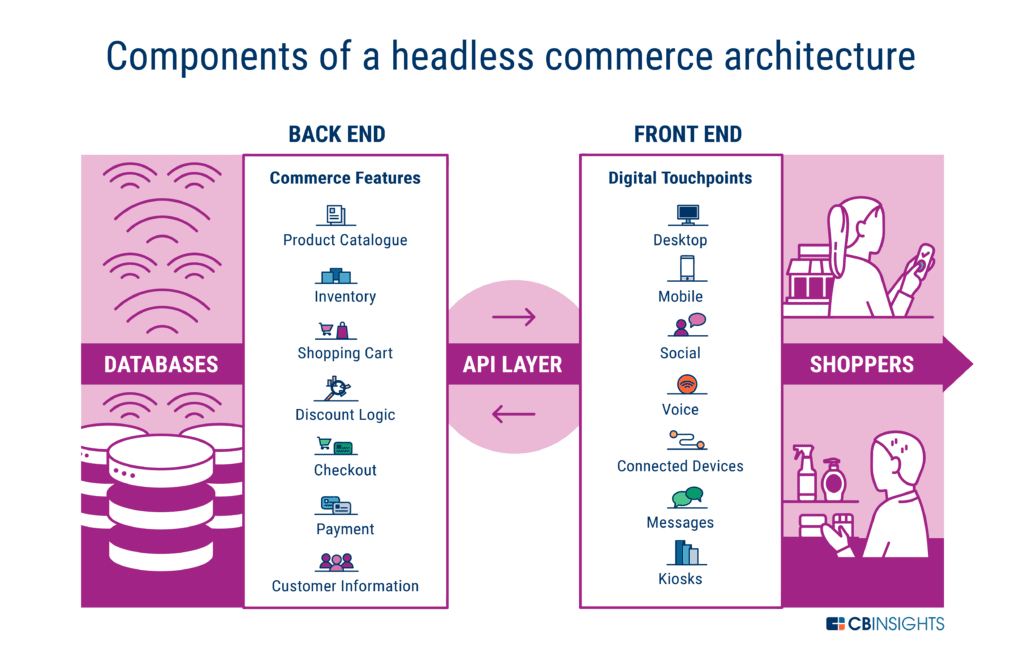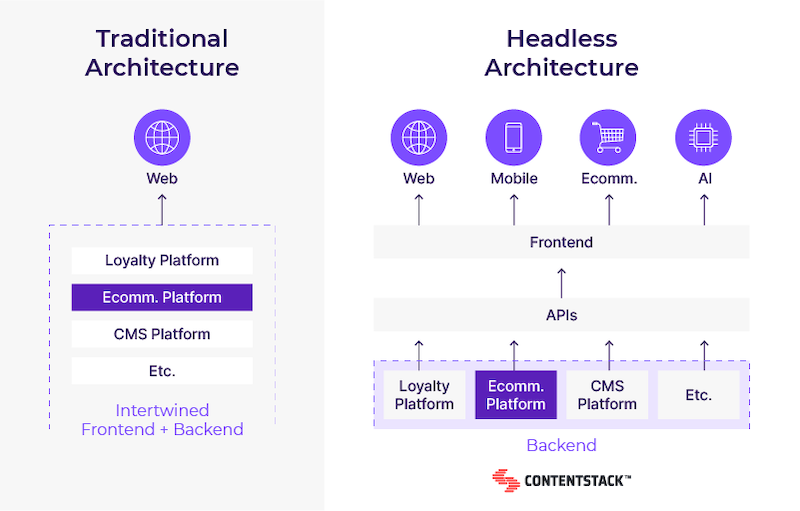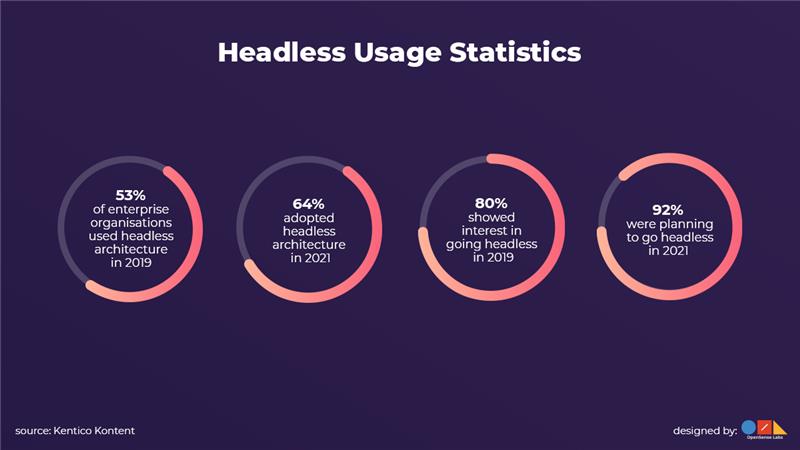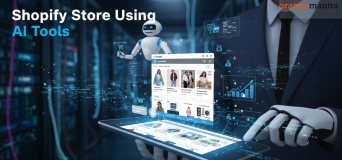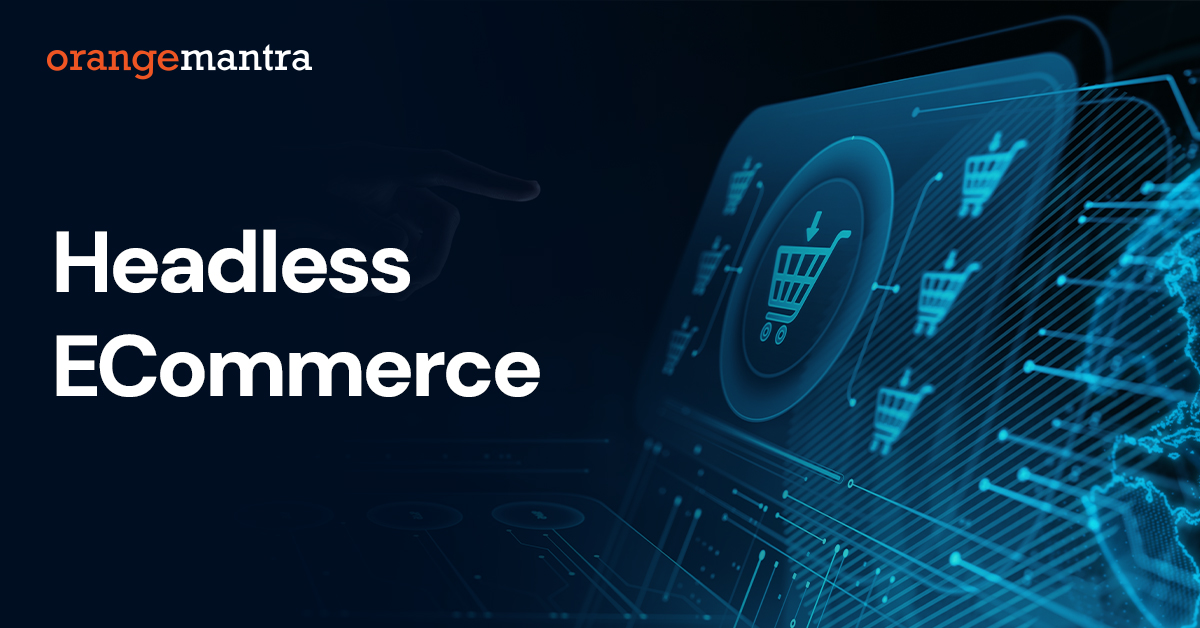
You’re battling fragmented customer journeys across devices. Headless ecommerce decouples your frontend (UX) from backend (logic), letting you deploy hyper-personalized experiences anywhere—fast.
Businesses are under pressure to continuously change to shifting consumer behaviors. Users no longer purchase in a straight line; instead, they switch between desktops & mobiles. Conventional e-commerce platforms connect a website’s frontend and backend. So, this fails to offer adaptable user experiences across these channels.
Headless ecommerce, a solution created to address these issues, comes into play here. However, headless web development services are a simpler idea than their daunting moniker suggests. Let’s examine why this strategy is causing a stir in the eCommerce industry.
Table of Contents
What does headless mean in ecommerce?
An eCommerce architecture known as headless ecommerce separates the ends. To put it another way, the front end is distinct from the back end. Because of this division, firms individually maintain the user interface without interfering with server-side processes.
Imagine being able to update your online store’s look and feel. And that too without making changes to the order management system. It makes it possible for businesses to give users faster, customized, and flexible digital experiences.
A look at the statistics around the globe
- The market size was valued at $1.32 billion in 2020 and is expected to reach $13.08 billion by 2028, reflecting a remarkable CAGR of 30.1%.
- The headless CMS market is expected to reach $3.8 billion by 2032.
- 73% of all businesses are currently using headless website architecture.
- Among those not currently using headless, nearly 98% plan to evaluate headless solutions over the next 12 months.
- Over six in ten retail companies plan to migrate to headless ecommerce platforms by 2024, while over 20 percent already use them.
- Over six in ten retail companies plan to migrate to headless ecommerce platforms by 2024, while over 20 percent already use them.
Working of a headless ecommerce architecture
The API layer is crucial to headless ecommerce, which links the front-end to back-end systems. The frontend can retrieve data from the backend using this interface and optimize the user experience.
Both layers can develop independently with this API-driven communication. Companies can create a modern mobile app interface while maintaining the data architecture and business logic.
If you wish to introduce a new mobile application for your shop. To support the app functionality on a standard platform, you might redesign the back-end infrastructure. However, headless commerce reduces the need for intricate back-end changes.
Traditional vs. headless ecommerce: A look at the comparison
Here is how the two types of eCommerce architecture differ.
Architecture
- Traditional Commerce: Frontend and backend are tightly linked like a fixed house where every room is built together.
- Headless eCommerce: The frontend and backend are separated like LEGO blocks; you can change one part without breaking the whole.
Flexibility
- Traditional: Limited flexibility. You’re stuck with the default design and features unless you rebuild major sections.
- Headless: Highly customizable. Change storefront designs and add new channels (apps, kiosks) without any backend. You can use headless eCommerce platforms to build your customized apps.
Performance
- Traditional: Heavier, slower-loading pages due to backend dependencies.
- Headless: Faster page loads and better performance with lightweight, modern front-end frameworks.
Omnichannel
- Traditional: Built mainly for the web. Expanding mobile apps or smart devices takes time and effort.
- Headless: Built for every channel—web, mobile, social, voice, and IoT using the same backend logic.
Maintenance
- Traditional: Any update can break things across the system. Fixes take more time.
- Headless: Update frontend or backend independently, reducing downtime and improving agility.
How does headless eCommerce benefit businesses?
Let’s look at some crucial advantages of using headless eCommerce.
Agile experts
Agility is one of the biggest benefits of headless ecommerce. Without waiting for back-end teams to make the necessary adjustments. And firms can swiftly and effectively implement modifications to their front-end experiences. Given how quickly consumer preferences are changing in the market today, this speed is essential.
Implementing a change to a website could take weeks or even months in a typical setting. The identical operations can frequently be finished in a fraction of the time with headless ecommerce.
Even internet behemoths like Amazon benefit from headless ecommerce agency tactics. Amazon is renowned for refreshing its front-end experience every 11.7 seconds to update weekly.
Flexibility
It is no longer necessary for brands to fit their design concepts within a strict structure. Complete front-end development is possible with headless ecommerce solutions for customized online stores. The options are unlimited, whether it’s a gamified checkout process or interactive chat support. The API guarantees seamless data flow from the backend to create innovative interfaces using contemporary frameworks.
Unified experience
Users engage with companies on a variety of platforms, like wearables, desktops, and mobile devices. Businesses offer a uniform experience across all of these channels using headless ecommerce.
A decoupled system allows each channel to have a frontend that is optimized for the user environment. Without sacrificing effectiveness, this strategy guarantees brand consistency and raises customer satisfaction.
Scalability
Compared to conventional setups, headless ecommerce solutions are quicker and scalable. The user experience is responsive since the front end just loads the data it needs from the API.
Organizations can also scale each layer separately thanks to this separation. Without affecting the back end, you can scale your front end if traffic increases there.
The future of headless ecommerce in 2025 and beyond
Here are some ways headless eCommerce development will help in the future.
Hyper-personalized shopping experiences
Headless architecture creates independent ends to design customized experiences across devices. It will include AI-powered product recommendations, personalized landing pages, and voice commerce interfaces tailored to each user.
Faster omnichannel deployments
Headless enables retailers to launch across web, mobile apps, kiosks, smart TVs, and even wearables without rebuilding the backend. This speed and flexibility will become essential in a world where shopping happens everywhere.
AI + Headless: A powerful pairing
Expect AI to power headless storefronts with dynamic content rendering and predictive analytics. Brands using AI + headless will stay ahead by offering smarter, faster, and intuitive customer journeys.
Composable commerce
The future is modular. Businesses will build their eCommerce stack using the best solutions. It mixes CMSs, search tools, checkout systems, and marketing platforms that plug into a headless core. It ensures agility and scalability.
Higher sales conversions
Performance matters. Headless storefronts powered by frameworks. React, Vue, or Next.js offer lightning-fast load times. Resulting in improved SEO, reducing bounce rates, and driving better conversion rates.
Global expansion
With headless, businesses can create region-specific storefronts with different languages. And even layouts make global eCommerce seamless and efficient.
Stronger Security
By decoupling the front-end, potential attack surfaces are reduced. Plus, updates to one layer don’t disrupt the whole system, making long-term maintenance smoother.
Our work in the eCommerce sector
The eCommerce client provides an intuitive user interface and a valuable sales channel.
The online kidswear brand now has a significant digital presence and generates strong revenue and ROI.
Conclusion
The complexity of customer expectations will only increase as digital commerce develops further. Legacy platforms will have a harder time keeping up with these demands. A forward-thinking solution, headless commerce enables companies to act swiftly. Or you can consult headless ecommerce development services for more assistance.
FAQs
Q1. What is the process of headless ecommerce?
Brands may create unique experiences that customers can’t find elsewhere with the help of headless commerce. APIs are essential to this because they guarantee synchronized, brand-consistent experiences across channels, powered by shared commerce services like inventories, promotions, product details, and more.
Q2. Does headless e-commerce make sense?
Businesses looking to develop distinctive and captivating purchasing experiences find headless e-commerce to be an appealing option because of its unmatched flexibility and innovation possibilities. It’s not a one-size-fits-all solution, though.
Q3. What distinguishes headless ecommerce from PWA?
After knowing their meanings, we suppose it’s easy to distinguish between those two. PWA is a frontend application, but headless technology is essentially about the interaction between a website’s frontend and backend.
Q4. How much does headless ecommerce cost?
It depends on the timelines and requirements. An agency may charge per hour. A Shopify eCommerce project will adjust in range from $100.00 to $100,000. And this may vary as per the needs, users, app size, and features for your business.
Q5. Is headless CMS the way of the future?
One effective method for future-proofing your company is Headless CMS. You can learn from your audience while optimizing your digital experience, brand, and content assets by developing a strong platform.
Looking to get a headless commerce development company for your B2B business?
